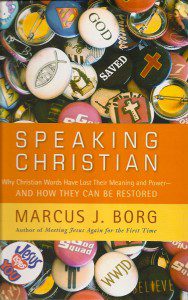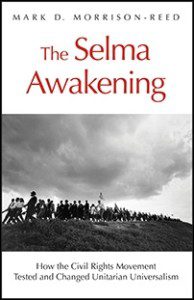Note: If you want to skip to the section specifically on Mark 1:14-20, scroll down to parts two and three, but the introduction and part one help set-up these later sections.
but the introduction and part one help set-up these later sections.
Introduction
We’re familiar with the Gospel According Matthew, Mark, Luke, and John, which are each quite distinct. Many of us are even familiar with the Gospel According to Thomas, Mary, and Q. But what is the Gospel According to You from the vantage point of twenty-first knowledge? What is the Gospel According to Your Church?
Since the word “gospel” is synonymous with “Good News,” I also invite you to consider your response to the related question, “What is the Good News According to You and According to Your Congregation?” What aspects of your church are good news: good news for you, good new for us, good news for the fellow citizens of your city or town, or good news for the world?
What good news do we have to share about who Jesus is, who God is, or what insights we are living into about how to live an abundant life according to the way of Jesus? These related questions seem appropriate as we reflect on these verses from the opening chapter of the Gospel — the “good news” — according to Mark.
At the same time, someone could object that asking, “What is the Gospel according to You or Your Church?” may be an inappropriate question: who are we, after all, to write our own Gospel? But telling the story of God’s good news in a particular time and place and for a specific community is exactly what Mark was doing in the first century, which is why we call his book the Gospel . . . according to Mark. Similarly, both Matthew and Luke had copies of Mark on their desks when they were writing
Both Matthew and Luke adapted, edited, and supplemented Mark’s Gospel for their particular communities. John did likewise. So, just as Matthew and Luke emulated the Gospel Mark as they attempted to tell the good news in their time and place, I invite you to allow Mark’s first-century effort to inspire you to consider how God is calling you individually and us collectively to share the good news of God in this time and place.
If you have time, consider giving yourself permission to pause now in contemplative silence to reflect on the questions, “What is the good news according to me?” and “What is the Gospel according to my congregation?” Journal your response.
Of course, in many congregations, there will be a broad range of views of how people understand the meaning of “Gospel” or “good news” both for the first century and for today. But you can take some comfort that the early church was in the same position, which is why we have — not one but — four canonical Gospels, as well as many other non-canonical Gospels.
The early followers of Jesus were not content with Mark’s effort to tell the good news of Jesus, so they continued to tell and write about Jesus for their specific communities. But I want to emphasize that beyond there being at least four major versions of the Gospel in the official biblical canon — in the form of the books we call Matthew, Mark, Luke, and John — we can see at least three variations of the “Gospel” or “good news” even within chapter one of the Gospel of Mark alone.
Part One:
Mark’s Good News About Jesus (Mark 1:1)
In Mark chapter one, the phrase “good news” appears three times, and in each instance, there is a different nuance of meaning. In verse one, Mark tells us that his book concerns the “good news of Jesus Christ.” In verse fourteen, Jesus comes proclaiming the “good news of God.” And, in verse fifteen, Jesus instructs us to “believe in the good news.” So, at least in the first chapter of Mark, the phrase “good news” has at least three different shades of meaning. We have Mark’s good news about Jesus, Jesus’ good news about God, and Jesus’ invitation to believe in the good news.
Let’s look more closely at each one in turn. First, in verse one, we have Mark’s good news about Jesus. Mark writes, “The beginning of the good news of Jesus Christ.” With his opening sentence, Mark is letting us know the genre of his book. This first line is the “beginning” of a book in the genre of “Gospel” or “good news” — specifically, good news about the life and teachings of Jesus.
From our perspective, in the wake of 2,000 years of Christian history, writing about the “good news” of Jesus can seem unremarkable given the countless numbers of books that have been written about Jesus. But writing a Gospel about Jesus in the closing decades of the first-century was far less intuitive. Jesus of Nazareth was an obscure Jewish peasant, whom the Romans crucified around the year 30. The fact that we do not even know with certainty the year in which Jesus died is one of the clearest indications of how obscure Jesus was. History books have always been quick to record details about the lives of the rich and famous, but we often have little-to-no information about the lives of commoners. And the overwhelming masses of human beings always have been the commoners. Again, as a result, we do not even know the year that Jesus died. We only know the approximate time of year because his death coincided with the festival of Passover.
Living at a point in history when we can go to any bookstore and find more books on Jesus than we will ever have time to read, we can have difficulty appreciating both the audacity and ground-breaking nature of Mark’s undertaking. The situation is similar to my experience in many art museums. I do not think I have ever been to a modern art exhibit without hearing someone say that their two year old could have made a copy of some masterpiece hanging on the wall. And many two-year-olds could indeed make a passable replica of some pieces of modern art, but the two-year-old’s work would be just that: a mere replica — not a ground-breaking, paradigm-shifting original. And the difference between an original and a replica is precisely the reason why a Jackson Pollock drip painting made in 1948 sold for approximately $140 million dollars in 2006, whereas you can buy a print a color replica of the painting for free from the Internet. Similarly, Mark’s Gospel is a priceless original — which has been continually read and studied by countless millions of people for 2,000 years — whereas today most of the books written over the centuries about Jesus are read by only a few, if they are read at all.
Before the Gospel of Mark, in addition to oral tradition, there were the letters of Paul, mostly written during the 50s of the first-century, about twenty years after Jesus’ death. And there seems to have been lists of Jesus’ sayings in circulation — represented, some scholars say, by the “Gospel of Thomas” or by the hypothetical “Gospel of Q” — but we only call these two works the “Gospel of Thomas” and the “Gospel of Q” because the scholars that work on these two books wanted them to be compared to full-fledged Gospels like the Gospel of Mark.
However, neither Q, nor Thomas makes a claim for itself to be a “Gospel.” Thomas, for instance, is simply a list of 114 sayings of Jesus. Accordingly, Thomas’ book begins, “These are the secret sayings that the living Jesus spoke and Didymos Judas Thomas recorded.” Mark, however, is not a list of sayings, but a book in the genre called “Gospel,” and his decision to write a gospel about Jesus was breathtakingly audacious, groundbreaking, and original at the time.
According to scholars of ancient Rome, gospels in the Roman Empire were typically “Roman propaganda.” Remember that the greek word we transliterate as Gospel literally means “good news.” Thus, Roman gospels would herald the good news of a Roman “military victory . . . or of the ascension to power of a new emperor.” Imperial subjects in the Roman empire, would be all too familiar with Roman gospels because it was in Rome’s interest to spread Roman military and political propaganda in order to keep the famous peace of Rome, the so-called Pax Romana.
There is, of course, a sense in which Mark is simply writing a biography about Jesus — a person Mark found significant — in the same way that we have biographies from the first century of other famous Greco-Roman figures. But Mark’s choice to write about Jesus and, in particular, to begin his biography of Jesus with the word Gospel is pivotally important. In a context saturated with the gospels of Rome military prowess, the Gospel of Mark both inverted and subverted the normative gospel genre of the Roman Empire. Over the coming weeks, we will see how in sixteen chapters Mark inverts what appeared to be a victory of the Roman Empire — the crucifixion of Jesus, whom the Romans viewed as a minor insurrectionist — into good news for communities like Mark’s who sought to follow the way of Jesus. Ironically, from the perspective of the Romans, Jesus’ crucifixion was not even close to significant enough to merit the writing of a Roman gospel. From their perspective, Jesus’ death did not warrant the effort of writing a Gospel to be proclaimed around the empire. The execution of Jesus and the scattering of his followers was not the sort of ‘victory’ that the Roman viewed as worthy of propaganda. Mark takes that very genre of Roman propaganda to proclaim the Gospel that the life and teachings of Jesus remains good news despite the best efforts of Rome to silence the Jesus movement.
But the date of Mark’s writing is vital to understanding the level of boldness, audacity, and paradigm-shifting significance of Mark’s use of the gospel genre. Mark is writing to the Christian church of which he is a part around the year 69 CE, in the middle of the Roman-Jewish War, which lasted from around 66-73. The seriousness of the Roman-Jewish War is seen in that not long after the writing of Mark’s Gospel around July or August of the year 70, the Romans, in retaliation to the Jewish uprising, destroyed the Second Jerusalem Temple, the only remnants of which remain are today called the “Wailing Wall.”
When trying to understanding the Gospel of Mark’s first-century perspective from our twenty-first century context, we cannot remind ourselves too often of the historical event surrounding Mark’s writing. In the middle of the Roman-Jewish War, Mark uses the genre of gospel — a genre typically associated with glad tidings from the battlefield regarding Roman military victories or with the good news of a new Roman emperor — to tell the subversive good news of Jesus, a Jewish peasant whom the Roman had crucified decades earlier. As I said earlier: breathtaking.
Recall also the example I shared earlier of the art museum. A two year old may indeed be able to replicate the style of Jackson Pollock’s “drip art” in which he laid a canvas on the floor, then dripped and flung paint. But the significance of Pollock’s art — why students continue to study his paintings and why collectors pay millions at auction — is, again, his originality. Pollack’s significance is in helping catalyze the movement of abstract expressionism, which shattered the constraints of representational art. Previously, paintings had almost always been about a “second thing”; the painting represented — literally re-presented — an aspect of nature, whether a building, a person, or a landscape. But abstract expressionism showed that art can be sufficient in itself — an exploration of form, line, and color — without having to re-present something outside itself. And the author of Mark’s Gospel is as subversive, original, and significant to the Jesus movement as Pollack was in the art world. There were other Jesus Gospels that followed Mark, and some of them are certainly better written, since Mark is infamous for his unsophisticated Greek writing style. But Mark is timelessly significant in his originality and audacity.
To those of us who have grown up as Christians in the United States, hearing Mark’s opening verse can seem unremarkable, but those opening words — about the good news of Jesus — were a potential powder keg in the midst of the Roman-Jewish War. Imagine whether you would have the audacity to write publicly about the good news of Jesus if the United States government were in the middle of forcibly tearing down churches like the National Cathedral. To summarize, one meaning of the phrase “good news” is the entirety of the Gospel of Mark — that is, Mark’s effort over the course of his entire book to use the genre of Gospel (typically reserved for Roman propaganda) to tell the good news of Jesus, an obscure figure the Romans themselves had executed.
Part Two:
Jesus’ Good News about God (Mark 1:14)
A second meaning of “good news,” in addition to Mark’s good news about Jesus, is Jesus’ good news about God. In verse fourteen, we read that “Now after John was arrested, Jesus came to Galilee, proclaiming the good news of God.” Jesus’ proclamation of the good news at the beginning of his public ministry is crucially important. Here the good news is clearly not about Jesus’ death; instead the good news is about what Jesus calls the “kingdom of God” — that is, the way of being in the world when God is in charge instead of Caesar.
One aspect of historical Jesus studies that almost all scholars actually agree about is that a central aspect of Jesus’ ministry concerned speaking about the kingdom of God. And to speak about God being king, when Caesar had declared himself divine, was audacious to say the least. Accordingly, I am persuaded that Mark found the courage to subvert the Roman understanding of gospel from Jesus’ own courageous proclamation of God as the rightful king, not Caesar. However, we too often forget that Jesus, in turn, found his inspiration from the Hebrew prophets.
After the Hebrews escaped from slavery in Egypt, they tragically fell into a pattern replicated across human history: we humans — after finding liberation from some type of enslavement — all too often recreate some new form of the slavery we thought we had left in the past. In this case, the Hebrews, having escaped the despotic monarchy of Pharaoh in Egypt — another human who, like Caesar, had declared himself divine — naively began to demand a king to rule them. Prophets like Samuel tried to warn the people that kings would conscript their children for armies, take the first fruits of their harvests, and demand taxes; but the people did not listen. So when Jesus spoke of the kingdom of God, he and his early Jewish followers would have naturally recalled the Hebrew stories of the past (the escape from slavery under Pharaoh and the recurring prophetic warnings to trust God more than human kings) as well as the current Jewish situation in the present, where the Roman Caesar made claims to be divine and often ruled unjustly over the Jewish homeland.
Part Three:
Jesus’ Call to Believe the Good News (Mark 1:15)
To recapitulate, we have Mark’s contrast of the good news of Jesus over against the good news of Roman military power as well as Jesus’ good news of God as the right and true “king,” not Caesar. Now finally, we have Jesus’ call to believe in the good news. “The time is fulfilled, and the kingdom of God has come near; repent, and believe in the good news.” Here we see that long before other versions of aspects of the good news, which involve Jesus’ crucifixion and resurrection, we have Jesus proclaiming the Gospel, not of his impending death, but of the kingdom of God — a way of living here and now on this earth that Jesus modeled with his own life and which we are invited to model in our time and place.
As you continue to reflect on your response to the questions, “What is the good news of according to me?” and “What is the Gospel according to my congregation?” keep in mind the many ways that the Gospel has been told in the past from the four-fold good news of the Gospels of Matthew, Mark, Luke, and John to the three different variations of the good news in the first chapter of the Gospel of Mark.
As we continue to read in Mark chapter one, we see that Jesus does not wait for people to come to him to tell the good news of God. Instead, Jesus takes the initiative to call his first disciples — because if you have really good news, you want to share the good news with others. And I submit to you that one of our challenges — beyond the important first step of discerning the good news according to us or our church — is following Jesus’ example of taking the risk of sharing our Gospel with others who may find a progressive, open-minded way of being church to be good news.
I offer that challenge with some trepidation. I have never been much of an evangelist. I remember, as a teenager, attending a Southern Baptist conference called Evang-olympics. Every person in attendance was challenges to take a Bible and distribute this Bible to the first person that God laid it on their heart to evangelize. I confess that I carried that Bible in my backpack for more than three years. And, to use the language of my childhood church, God never laid it on my heart to share that Bible. Instead, contrary to what I was told I would find at the Evang-olympics conference, most of the non-Southern Baptists I met were more kind, well-adjusted, smart, funny, and competent human beings, than most of the Southern Baptists I already knew. At the same time, church growth studies resound with the advice that the only reliably effective way of growing a church is for the current members of the church to tap into their existing social networks.
Application
I invite you now to enter into a time of contemplative silence to reflect on the following questions.
- “What is the good news of according to my church?
- “What is the Gospel according to me?
- “Whom among your friends and family, acquaintances and co-workers might find your way of being church to be good news?”
Bonus
At the end of last year, I blogged through a lecture series by Marcus Borg about his latest book Why Christian Words Have Lost their Meaning and Power and How They Can Be Restored. Some of the relevant highlights to this lectionary passage:
- Toward an Understanding of Christianity’s Core Message. A memory exercise: At the end of childhood (approximately age 12), imagine you had been asked to state the heart of the Christian message (“the Gospel,” the “Good News”) in a sentence. [Something Tweetable.] Why does Christianity matter? What should you or anybody be a Christian? Take 3-4 minutes of silence to imagine yourself at this age, then journal your response.
- Borg’s one-sentence, childhood answer: Jesus died for our sins so that we could be forgiven and go to heaven if we believe in him. (Emphasis: afterlife, our sinfulness, Jesus’ death, believing. This view is “Heaven and Hell Christianity” or “Belief-centered Christiainity.”
- Today he would say that the Gospel, the “Good News” and salvation is all about transformation in this life: the transformation of ourselves and the world, both personal and political, individuals and society — see the Jewish conception of tikkun olam(“to heal, repair, and transform the world”).
- In Mark 1:15 (the earliest canonical Gospel), the “Kingdom of God” is not about Jesus’ death. Jesus didn’t come to die. Instead, Jesus was was killed because of how he lived (similar to why and how figures such as Oscar Romero, Martin Luther King, Jr., Gandhi, and Yitzhak Rabin were martyred in the twentieth-century). The consensus of New Testament scholars for decades has been that the kingdom of God (or “dream of God”) is central to Jesus’ life and teaching. And God’s dream is for this world to be characterized by justice and peace, just as the Hebrew prophets desired. [For more, see Walter Wink’s book The Powers That Be: Theology for a New Millennium.] On the “kingdom of God” as “God’s dream,” see Verna J. Dozier’s 1991 book The Dream of God: A Call to Return. More recently, Archbishop Desmond Tutu has write an adult book (God Has a Dream: A Vision of Hope for Our Time) and a children’s book (God’s Dream) on these themes.
The links to all the lectures are available at the top of this post.
Notes
1 For an introduction to the process of canonization as well as to the non-canonical Gospels, see Bart D. Ehrman, Lost Christianities: The Battles for Scripture and the Faiths We Never Knew (Oxford University Press, 2005).
2 For an example of history told from the underside (that is, the perspective of “commoners”), see Howard Zinn’s A People’s History of the United States, which tells the history of the U.S. from the point of view of “blacks, women, American Indians, war resisters, and poor laborers.”
3 Carol Vogel, “A Pollock Is Sold, Possibly for a Record Price.” The New York Times (2 Nov 2006) available at www.nytimes.com/2006/11/02/arts/design/02drip.html.
4 For more on the Gospel of Q, see John S. Kloppenborg, Q, the Earliest Gospel: An Introduction to the Original Stories and Sayings of Jesus. For more on the Gospel of Thomas, see Elaine Pagels, Beyond Belief: The Secret Gospel of Thomas.
5 gospels in the Roman Empire were typically “Roman propaganda.” Remember that the greek word we transliterate as Gospel literally means “good news.” Thus, Roman gospels would herald the good news of a Roman “military victory . . . or of the ascension to power of a new emperor.” — see Ched Myers, et al. “Say to This Mountain”: Mark’s Story of Discipleship (Orbis 1996), 5-6.
6 The seriousness of the Roman-Jewish War is seen in that not long after the writing of Mark’s Gospel around July or August of the year 70, the Romans, in retaliation to the Jewish uprising, destroyed the Second Jerusalem Temple, the only remnants of which remain are today called the “Wailing Wall.” — see Joel Marcus. Mark 1-8: A New Translation and Commentary. The Anchor Bible (2000), 37.
7 The film Pollock (2000) is a biopic that shows the process of development in Jackson Pollock’s art.
8 1 Samuel 8:11-17, “11 “These will be the ways of the king who will reign over you: he will take your sons and appoint them to his chariots and to be his horsemen, and to run before his chariots; 12 and he will appoint for himself commanders of thousands and commanders of fifties, and some to plow his ground and to reap his harvest, and to make his implements of war and the equipment of his chariots. 13 He will take your daughters to be perfumers and cooks and bakers. 14 He will take the best of your fields and vineyards and olive orchards and give them to his courtiers. 15 He will take one-tenth of your grain and of your vineyards and give it to his officers and his courtiers. 16 He will take your male and female slaves, and the best of your cattle and donkeys, and put them to his work. 17 He will take one-tenth of your flocks, and you shall be his slaves.”
9 For more on the “kingdom of God” as part of the anti-kingship tradition of Israel, see Ched Myers, Binding the Strong Man: A Political Reading of Mark’s Story of Jesus (8) as well as Walter Brueggemann’s The Prophetic Imagination.
10 For more on progressive views of Christian history, salvation, and the atonement, see Rebecca Ann Parker and Rita Nakashima Brock’s magisterial book Saving Paradise: How Christianity Traded Love of This World for Crucifixion and Empire.
11 For more on evangelism, see Martha Grace Reese, Unbinding the Gospel: Real Life Evangelism, 2nd Edition.












